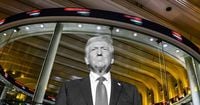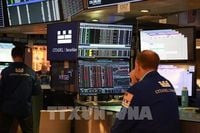In a rapidly evolving economic landscape, global stock markets are experiencing significant turbulence, primarily driven by concerns over President Donald Trump's impending tariff policies. As investors brace for potential impacts on the economy, the Asian-Pacific stock markets saw a notable decline on March 31, 2025, amidst fears surrounding the new tariffs expected to be announced this week.
The Nikkei 225 index in Japan plummeted by 3.67%, with losses exceeding 4% at one point, while the Topix index fell by 2.33%. South Korea's Kospi index dropped 2.29%, and the Kosdaq index was down 1.55%. Australia's S&P/ASX 200 index also fell by 1.62%. In mainland China, the CSI 300 index opened with a 0.28% decrease, and Hong Kong's Hang Seng index lost 0.78%. Taiwan's benchmark stock index is now nearing a "technical correction" threshold, having declined 10% from its peak.
As traders and analysts await clearer details regarding Trump's tariff strategy, U.S. and European stock futures also dipped. On March 28, 2025, the U.S. stock markets had already faced a downturn due to rising concerns over trade policy and inflation forecasts. The Dow Jones Industrial Average fell by 715.80 points (1.69%) to close at 41,583.90 points. The S&P 500 index lost 1.97%, settling at 5,580.94 points, marking its fifth weekly decline in six weeks. The Nasdaq Composite plunged 2.7%, closing at 17,322.99 points. Major technology companies, including Alphabet, Meta, and Amazon, also saw their shares decline, adding pressure to the overall market.
Investors are exercising caution, avoiding large transactions or portfolio adjustments to mitigate risks associated with Trump's reciprocal tax policy. This policy, which Trump has officially announced will apply to all countries, has raised alarms about the potential for escalating trade wars and their implications for the U.S. economy.
On March 30, 2025, Trump declared that he would unveil a large-scale tariff plan on April 2, 2025, which he referred to as "Liberation Day." He emphasized that the reciprocal tariffs would apply to all countries, stating, "It will start applying (reciprocal tariffs) to all countries." Trump explained that this date is significant because the U.S. will finally begin to collect money from these tariffs. Economists view this move as a culmination of Trump's "America First" trade policy, which he initiated on his first day in office with the aim of revitalizing U.S. manufacturing.
Previously, Trump had imposed high tariffs on aluminum, steel, and automobiles, along with increased taxes on all goods imported from China. White House economic advisor Kevin Hassett noted that the tariffs would primarily target 10-15 countries with the worst trade imbalances, although he did not specify which countries would be affected.
Concerns about potential trade wars are destabilizing markets and raising fears of an economic recession in the U.S. Trump has indicated that he will impose reciprocal taxes on countries that levy tariffs on U.S. imports. In February 2025, he directed trade officials to review each country and compile a list of appropriate reciprocal measures. However, last week, Trump suggested that Washington might narrow its reciprocal tax plans, allowing for some cases to receive lower taxes than those imposed on U.S. goods.
Adding to the complexity of the economic situation, U.S. economic data has recently shown a decline in consumer confidence, while prices are trending upward. Experts from Goldman Sachs predict that the Federal Reserve may cut interest rates three times this year due to tariffs hindering growth and increasing unemployment rates.
Moreover, Trump has indicated a potential "secondary tax" on Russian oil and countries that purchase oil from Russia if a ceasefire agreement is not reached concerning the ongoing conflict in Ukraine. As the third-largest oil producer globally, Russia's position in the market means that such a decision could have significant repercussions for the global economy, particularly affecting major customers like China and India.
In Asia, China's manufacturing Purchasing Managers' Index (PMI) for March reached 50.5 points, aligning with analysts' expectations and improving slightly from February's 50.2 points. Meanwhile, the Thai stock market is expected to reopen after a temporary suspension due to an earthquake in Myanmar, which had caused buildings to shake across the region. In South Korea, the stock market may experience volatility following the lifting of a 17-month ban on short-selling.
Looking ahead, the Reserve Bank of Australia is likely to maintain interest rates during the ongoing election period, while investors are also awaiting economic data from Europe. The upcoming U.S. jobs report will be a key focus for market participants at the end of the week, as they seek to gauge the overall health of the economy amidst these turbulent times.
As the April 2 deadline approaches, the world watches closely to see how Trump's tariff policies will unfold and what impact they will have on both domestic and global markets. With investors on edge, the potential for further market fluctuations remains high as uncertainty looms over international trade relations.






